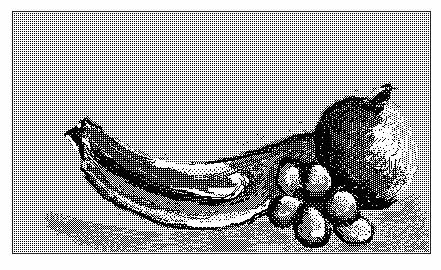
In early 1984 my professor and colleague at Bentley College, Dr. J. D. Robertson, brought one of the first Macintosh computers to his office. He told me to skip class and try out the new MacPaint software and odd little input device - the Mouse. We never looked back.
Up to this time I had been drawing pictures and creating fonts by writing programs on the Bentley mainframe, controlling HP color plotters. On the Mac there were only black and white pixels to work with, on a tiny screen. Above is the first drawing I made, my favorite subject, still life with fruit. It was a challenge to create depth and shading.
The result of that evening's work was a contract with DublClick Software in California to produce the clip art packages MacTut and WetPaint, which sold world-wide. I designed a few fonts too. We traveled to MacWorld Expos in San Francisco and Boston to promote sales. MacTut was featured in MacUser Magazine and at the Rameses exhibit at Boston's Museum of Science. (It was also used by real live British egyptologists, in Egypt!) I even sold MacTut tee shirts. The royalty checks continued for eight years. It was a wonderful experience.
Photos from MacWorld, Museum of Science, etc. (old, grainy, but fun to look back...)
Click the links below to view other early bitmapped samples. Use your browser's Back button to return here.
Small Gods. From MacTut, a sampling of Egyptian gods and godesses, paper-doll fashion. I included complete hieroglyphics fonts too. MacTut was showcased in an interactive exhibit at the Science Museum in Massachusetts during their Rameses exhibition.
Dinosaurs. One page with a few of the thousands of images I drew for the WetPaint clip art packages. The "paper-doll" egyptians from MacTut were popular, so I went on to make dinosaurs in the same fashion. To make them even more useable, I kept each image to icon size (32 pixels square) or double icon (64 pixels square).
Trains. A couple of the many train engines and cars I drew. These also could be fitted together to make larger images.
Pumpkins. Eventually the development of the postscript language enabled me to do drawings that were much smoother, though still black and white.
Daffodils. Another early postscript image, finally with the ability to use greys (color wasstill a dream for the future).
